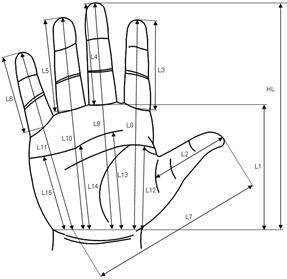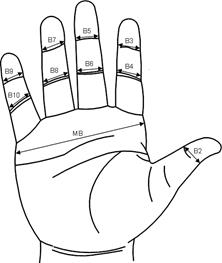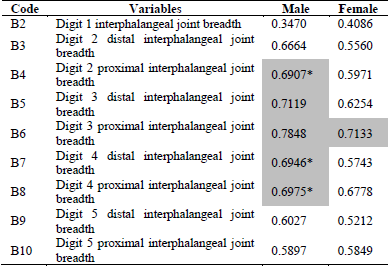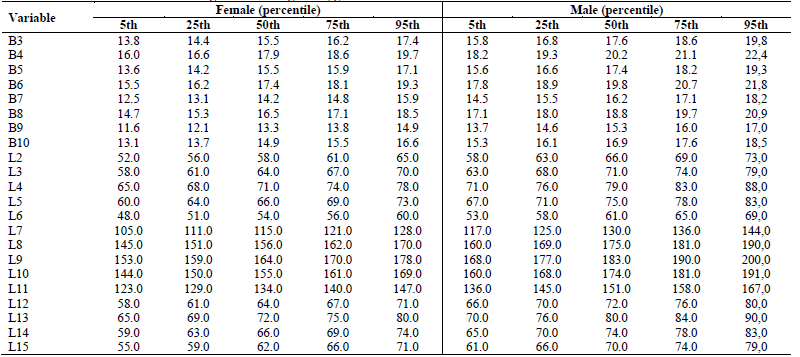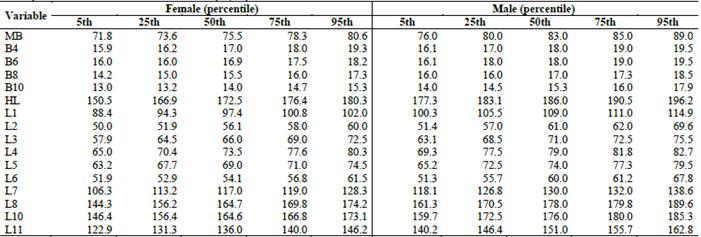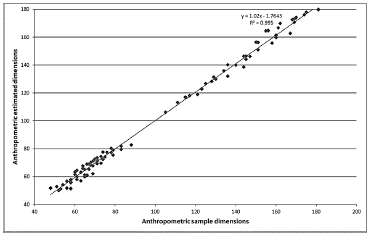1. Introduction
Traditionally, the sizing systems used for making gloves are defined on the basis of general anthropometric dimensions of the hand: length, circumference and breadth. When designing a glove, the dimensions of the fingers are defined by the total length of the hand, and as a result, frequently only one or two of them, the second and third, fit properly, while the gloves are usually too long for the first, fourth and fifth fingers [1]. This problem of a proper fit is critical, especially in sewn gloves made with laminar materials, such as leather, cotton canvas or other kinds of fabric, because production is based on cutting parts from patterns and then assembling them with seams.
Length, breadth and circumference dimensions are relevant to the sizing systems because of their high statistical correlations with other areas of the hand [2]. However, these measurements do not fully take into account the specific proportions of the fingers, which are a key factor for ensuring that the glove will fit the hand. At a preliminary stage in the research entitled Design of the sizing system for protective gloves, based on the anthropometry of the Colombian population [3], a process was established for defining the dimensions of the glove that was based on certain design requirements linked to the gripping function and critical areas of the hand, namely those concerned with its anatomy and sensitiveness. As a result of this part of the research, 35 relevant anthropometric dimensions of the hand were identified for adjusting each part of the glove [4].
Since working clothes and personal protective equipment must provide the worker with safety and comfort while he/she is engaged in his/her activity, these aspects should be taken into account when the respective items are being designed. In the case of sewn gloves, these are used when there is a need to protect the hands from friction when they come into contact with abrasive textures or surfaces, sharp edges and, in some cases, heat, and they are used in Colombia in such activities as construction work, agroindustry, maintenance, metalworking and general services. However, due to the relative lack of anthropometric data in Colombia, where little research has been conducted on the anthropometric characteristics of the population, limitations exist on designing a dimensionally-adjusted glove. The main study conducted in the country has been the one entitled Parámetros antropométricos de la población laboral Colombiana 1995 ACOPLA95 (Anthropometric parameters of the Colombian working population), which includes a sample of 1,315 males and 785 females between the ages of 20 and 59 [5]. Other studies have focused on specific working or age groups, such as companies in the flowers sector [6,7], bus and truck drivers [8], female workers in the car-parts industry [9], university students [10], and school students [11].
Most of these studies have focused solely on general body dimensions and include few measurements of the hand. Exceptions have been the studies conducted by García-Cáceres and colleagues [7], which focused on the anthropometry of flower-sector workers and were oriented toward the design and evaluation of hand tools, and the hand anthropometrics study in northern Colombia by Oviedo-Trespalacios and colleagues [12].
In view of the limitations on the availability of hand anthropometric data, and after reviewing different methods for estimating dimensions, we selected the ratio scaling method (RS) to compensate for the lack of dimensional data, so that this method can be applied in the glove design process. The advantages of this method, in comparison with others used for estimating anthropometric dimensions (such as regression equations or the combining of anthropometric dimensions), lie in the fact that it can be applied for estimating particular dimensions (in this case, specific segments of the hand) which are generally not included in general anthropometric studies, using correlations that exist between these dimensions and others that are known and generally are included in anthropometric studies (in this case, general hand dimensions, such as length and breadth).
2. Method
2.1. The ratio scaling method (RS)
It is possible from biometric similarity relationships to estimate new anthropometric data, because the proportions between segments are known [13]. One technique based on this kind of relation is the ratio scaling method [13-15]. This technique considers that although dimensions can vary widely between populations, proportions between the parts of the body are similar, and it is therefore possible to estimate the anthropometric dimensions of a given population, if the scale relationships of another identified dimension are known. However, experts recommend that care be taken when using this technique, since the reliability of the results depends on the correlation coefficients that exist between the measurements, although it may be reliably applied in cases where the Pearson correlation coefficient (r) is greater than 0.7 [14].
RS is based on calculating the value of E, as shown in eq.(1), which is equal to the ratio between a dimension (d x ), within a sample of a given population X, and a reference dimension for the same population (D x ).
When the correlation between these dimensions is greater than 0.7, the value of E can be used to estimate one of the dimensions in another population, as long as the reference dimension is known [14]. The procedure for applying RS consists of the following stages.
2.2. Identification of relevant dimensions
When gloves are being designed, anthropometric dimensions must be identified systematically, due to the complexity of the anatomy of the hand and finger movements when performing different types of grip. In a previous study, the relevant dimensions in the design process were identified by building the requirements of the gloves on the basis of the different types of grip and the anatomical characteristics of the hand [4]. These dimensions were classified in three groups: lengths (taken longitudinally along the hand), breadths (taken horizontally across the hand) and circumferences (of fingers and palm). The RS method was not used for calculating dimensions in the latter group, because they did not have the necessary correlation coefficient values between them, and the regression equations presented by Greiner were therefore used instead [16]. The calculation process for this group of dimensions is beyond the scope of this article, which focuses on using the RS method to estimate other anthropometric dimensions.
2.3. Defining reference dimensions
Based on the recommendations made by Kroemer et al. [14], three criteria were taken into account for establishing the reference dimensions of the hand (denominator in eq.(1)): I to have correlation coefficients with values of over 0.7 in relation to other measurements to be estimated; II to be the same kind of orientator (length or breadth) as the dimension to be estimated; and III to have data available in anthropometric studies of the Colombian working population. In this latter case, the ACOPLA 95 study [5] was taken into account, since this is currently the largest and most complete Colombian anthropometric study. In view of the age of this study (1995), comparisons were made with data provided in the research carried out by García-Cáceres and collaborators [7], since this was the largest and most up-to-date research published about the hand anthropometry of workers in Colombia at the time the research was conducted. Based on these criteria, hand length (HL) was defined as the length orientator and metacarpal breadth (MB) as the breadth orientator.
2.4. Review of correlation coefficients between dimensions
The correlation coefficients for the relevant dimensions were recorded on the basis of the Greiner study [16]. This is the biggest anthropometric study of the hand in the world and includes 86 dimensions taken from a sample of 2,307 persons (1,003 males and 1,304 females) in the United States. Table 1 shows the correlation coefficients (r) between hand length (HL) and other relevant lengths in the glove design (Fig.1), and Table 2 shows the correlation coefficients (r) between metacarpal breadth (MB) and other breadths (Fig.2). Values above 0.7, on which the RS method can be applied, have been shaded grey.
Table 1 Correlation coefficients between hand length (HL) and other relevant lengths in glove design.
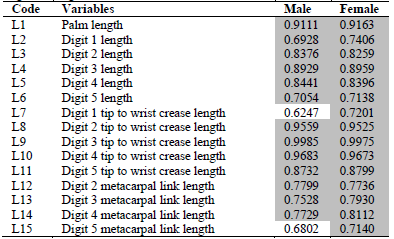
Source: The Authors.
2.5. Verification of ratio scalings from data available on the Colombian population
The similarity between scale relation values (E) was verified from data presented in two specific Colombian anthropometric studies. From the first study [5], two lengths were compared: palm length (L1) and hand length (HL) in seven percentiles, with the ratio scaling for each of them estimated. The values of the HL and L1 dimension for different percentiles are shown in Table 3, as well as the values of the scaling ratio E HL - L1 for the Estrada et al. and Greiner studies.
Table 3 Values of L1 (palm length) and HL (hand length) dimensions, expressed in mm, in the two reference studies.
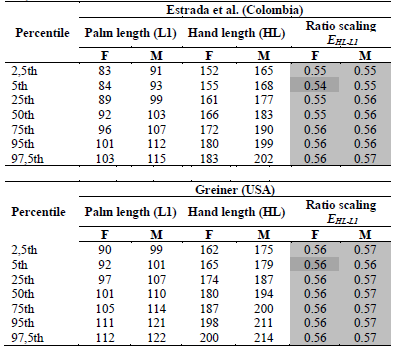
Source: The Authors.
It was noted that the ratio scalings range oscillates between 0.542 and 0.569 in the case of Estrada et al. and between 0.556 and 0.573 in Greiner, which shows a minimum variation between the ratios in these two studies.
Since the E HL -L1 values are ratios that are independent of the absolute values, they are compared in terms of their arithmetic differences. Data for the E value of each percentile was taken from the two studies and the difference is expressed in percentage terms. For example, for the E value for the 5th percentile of females (0.542 in Estrada et al. and 0.558 in Greiner), the difference, expressed in percentage terms, between the two studies was only 2.8%. Table 4 shows the differences between the E values in the two studies, expressed as absolute values and percentages, both by gender and by percentile. On average, the difference in females was 1.1% and in males it was 1.5%.
Table 4 Percentage differences between the EHL-L1 ratio scalings of the two studies (Estrada et al. and Greiner) for both genders.
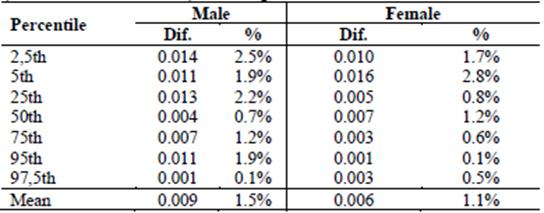
Source: The Authors.
In the second case, the ratio scalings were calculated between the lengths of the first (L2), second (L3), third (L4), fourth (L5) and fifth (L6) digits, with hand length (HL) taken from the data contained in the anthropometric study relating to the hand measurements of females working in the flowers sector in the Sabana de Bogotá [7] and those presented by Greiner. Table 5 shows the dimensions of the fingers presented in the two studies, and Table 6 shows the E values.
Table 5 Dimensions of the first (L2), second (L3), third (L4), fourth (L5) and fifth (L6) digits, expressed in mm, in the two reference studies.
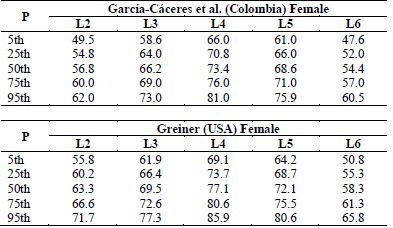
Source: The Authors.
Table 6 E-values between fingers and HL dimensions in the García-Cáceres et al. and Greiner studies.
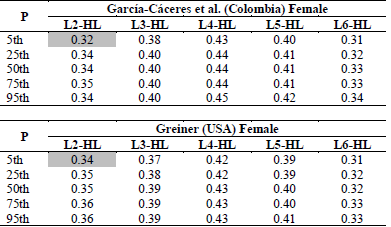
Source: The Authors.
In the case of digit lengths, the differences were also narrow. For example, the L2-HL ratios for the 5th percentile (0.32 in García-Caceres et al. and 0.34 in Greiner) showed a difference of 0.015 which, in percentage terms, is equal to 4.7%. Table 7 shows the differences between the E values for the length of each of the five fingers indicated above, taken from the two studies (García-Caceres et al. and Greiner), both in absolute values and in percentages.
Table 7 Absolute and percentage differences between finger ratio scalings in the two studies (García-Cáceres et al. and Greiner).

Source: The Authors.
The average differences in each of the fingers were 3.6% (L2), 2.9% (L3), 2.8% (L4), 2.6% (L5) and 0.9% (L6). This verification showed that the RS technique resulted in minimal differences between the E values calculated separately in the two studies, which corroborates the relevance of it being applied to estimate new anthropometric data.
2.6. Definition of ratio scaling
The value taken as reference (D x ) for the length dimensions (Fig. 1) was the HL (hand length) variable, while for breadth (Fig. 2) it was the MB (metacarpal breadth) variable. On the other hand, the E values were calculated separately by gender, with the dimensions presented in Fig.1 (lengths) and Fig. 2 (breadths) taken as numerator in eq.(1).
It is important to mention that the correlation coefficients between metacarpal breadth and digit breadth values greater than 0.7 occur only in two dimensions (B5 and B6) for males and in one (B6) for females, which is a primary criterion when using the RS method. In the data for males, there are three other dimensions where the correlation coefficients are between 0.69 and 0.7 (B4, B7 and B8). Table 9 shows the E values for finger breadths where the correlation coefficients are between 0.5 and 0.69 (mean correlation). As far as the Digit 1 interphalangeal joint breadth (B2) is concerned, the correlation coefficients are quite low (0.347 for males and 0.408 for females) in relation to the metacarpal breadth, and the calculation was therefore not considered in the estimations.
Tables 8 and 9 show the E values for the labeled variables, differentiated by gender and calculated for the 5th, 25th, 50th, 75th and 95th percentiles, based on the anthropometric data presented by Greiner [16].
Table 8 E scale ratios between different length dimensions and the HL variable (hand length).
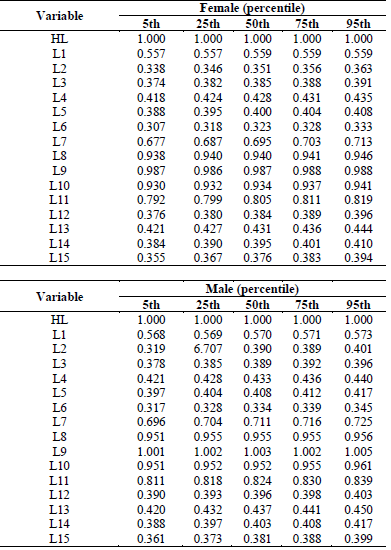
Source: The Authors.
Table 9 E scale ratios between breadth dimensions and the MB variable (metacarpal breadth).
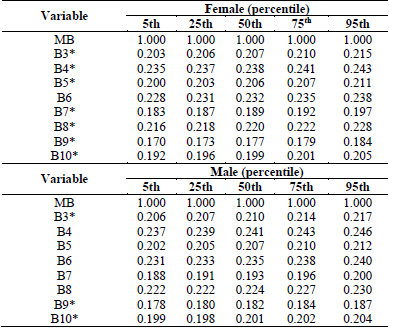
*. Dimensions with correlation coefficients where MB is between 0.5 and 0.69.
Source: The Authors.
The RS method could be applied satisfactorily for both length and breadth dimensions. In the case of hands, the majority of correlations between the dimensions are above the limit value of 0.7 for the two genders.
3. Results
3.1. Estimation of anthropometric dimensions
From the calculated E values, lengths and breadths were estimated for both genders and 5th, 25th, 50th, 75th and 95th percentiles, using hand length (HL) and metacarpal breadth (MB) as reference dimensions, respectively. The datapresented in the most extensive available anthropometry study of the Colombian population, namely the one carried out by Estrada et al. [5], was used for both variables. The estimated dimensions are shown in Table 10. This estimated data could apply for members of Colombia’s working population between the ages of 20 and 60, according to the scope of the reference study.
3.2. Verification of dimensions through anthropometric measurements
As part of the research, measurements were made of different anthropometric variables of the hand, 16 of which coincided with those estimated using the RS method (Table 11). The only dimensions included in this measurement process were those that applied to the redesigning of the glove pattern and fitting system. The sample size was calculated from the guidelines stated in ISO standard 15535, General Requirements for Establishing Anthropometric Database [17], by applying eq. (2), which establishes a minimum number of subjects (n) taken from a random sample, in order to ensure that percentiles 5 and 95 in a database estimate percentiles 5 and 95 of the real population, with 95% reliability and an established relative accuracy percentage. In eq. (2), CV is the variation coefficient in the anthropometric dimension and α is the desired relative accuracy percentage.
CVs were calculated for HL and MB using data from the Estrada et al. study and, as established in the standard, the anthropometric dimension with the highest relative variability (CV) was taken for calculating sample size. The CV for variable HL, which was 5%, was taken. When eq. (2) is applied using these values, together with a relative accuracy figure of 3%, the minimum sample size is found to be 25 persons. 41 participants (18 females - 23 males) from the Cundinamarca - Boyacá high plains region who worked in general services (cleaning, maintenance) were measured, using a sampling method that was stratified by gender. There were two criteria for inclusion, namely to be between 18 and 60 years of age (age range comparable to that in the reference study and which corresponds to the active working population), and to give their consent to participating in the measurement. The criteria for exclusion were to have some type of disability in the hands that affected the osteoarticular structures, to have amputations that compromised some area of the hand, or to have withdrawn consent. Measurements were taken by the head researcher for the study, using a L & W® vernier caliper (0.1 mm accuracy) and a SECA® 201 measuring tape (1.0 mm accuracy). All measurements were taken on the right hand. Processing of the information was carried out using the statistical functions of the MS Excel 2010® spreadsheet.
The Pearson correlation coefficient was used for verifying the similarity between estimated values and measured values, and hence for reflecting the strength of the relationships between the dimensions estimated and the RS method, with reference to the dimensions obtained directly from the sample of people. Those values were calculated separately for each percentile and gender (Table 12).
Table 12 Pearson correlation coefficients between the estimated dimensions and those obtained in the anthropometric sample.
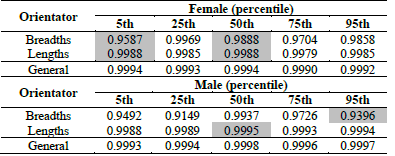
Source: The Authors.
In general, the values ranged from 0.9396 to 0.9995 for males and from 0.9587 to 0.9988 for females. The scatter plots that refer to gender show a slightly higher linear correlation for males (Fig. 3, R2 = 0.9985) than for females (Fig. 4, R2 = 0.9982). When the two genders are analyzed together, there is a slight decrease in the correlation (Fig. 5, R2 = 0.9976).
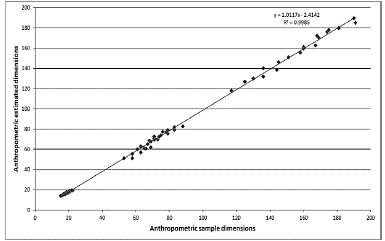
Source: The Authors.
Figure 3 Scatter plots for male data, estimated dimensions and those obtained from the anthropometric sample.
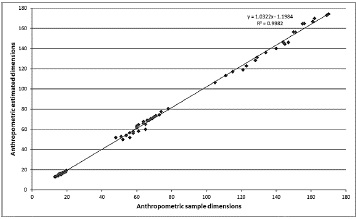
Source: The Authors.
Figure 4 Scatter plots for female data, estimated dimensions and those obtained from the anthropometric sample.
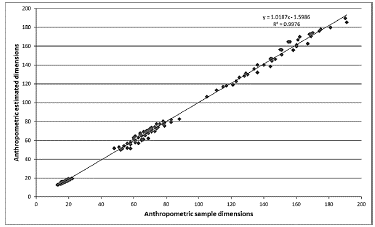
Source: The Authors.
Figure 5 Scatter plots for data relating to both genders, estimated dimensions and those obtained from the anthropometric sample.
Differences between length and breadth dimensions are found when correlations are analyzed by orientator type measurement. In the case of breadths, the correlation (Fig. 6, R2 = 0.8914) is smaller than for lengths (Fig. 7, R2 = 0.995).
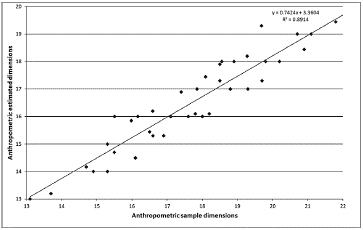
Source: The Authors.
Figure 6 Scatter plots for breadths data, estimated dimensions and those obtained from the anthropometric sample.
4. Discussion
The process of estimating anthropometric dimensions involves a series of methods through which it is possible to combine, interpolate and compare existing dimensions in order to estimate additional dimensions that are of specific interest. This estimation is necessary because some dimensions, which may be required after the studies have been published, are usually excluded in anthropometric studies due to monetary and time constraints [13]. The RS method is classified among methods founded on biometric similarity relations and is based on the fact that, when comparing two populations, absolute dimensions are different but proportions are similar. For example, for equivalent gender and percentiles, the values of the hand dimensions reported in Greiner's research with the US Army are higher than those of the Colombian population reported by Estrada et al., but when the E-scale factors, which were calculated independently using data from the two studies, are compared, the differences are minimal, as can be seen in Tables 4 and 7, where the average difference is 1.1% in females and 1.5% in males, in the case of the palm length - hand length relation. The RS method has already been used to estimate anthropometric dimensions from data existing in studies carried out on general populations in Turkey [18], Singapore and Indonesia [19], using height as a reference measurement. In the current study, hand length and breadth were used to estimate dimensions of the same body segment, which means that the deviations are smaller and, hence more reliable.
A novel feature of this research is the fact that after the correlations between the dimensions estimated using the RS method were calculated, these same dimensions were then taken directly in an anthropometric sample (lengths and breadths), which means that the same dimensions can be compared in the same percentile. As a result of this methodology being used, when the estimated data was compared with that taken directly from the anthropometric sample, high correlations (between 0.9396 and 0.9998) were found. Moreover, when comparing data on males (R2 = 0.9985) and on length dimensions (R2 = 0995), the correlations are slightly higher than for data on women and breadths, respectively. When this information is used to design items where a range of adjustments to the anatomy of the body is required, the differences between the results of the methods are not relevant. For practical purposes, the accuracy obtained when the RS method is used is adequate, considering that when anthropometry is applied in the design process, dimensions have to be modified, in order to provide clearances that allow adjustments to be made to the body, and also increased, due to the use of clothing and footwear; additionally, tolerances between sizes have to be managed [20]. ISO 20685:2005 standard establishes a maximum admissible value of 1.0 mm as the difference between a digital model and the direct measurement of the hand [21]. In the anthropometric study conducted by Estrada and colleagues among the Colombian population, a tolerance of 1.0 mm was applied for the measuring instrument, 3.0 mm for the hand length dimensions, and 2.0 mm for the breadths [5]. It should be pointed out that the mean correlation level in the correlation coefficients between metacarpal breadth (MB) and finger widths is between 0.5 and 0.7, mainly in females. This gender difference should be studied in greater detail when designing items with greater finger adjustment requirements.
At present, much work that is done on anthropometric studies relies on digital resources. The RS method becomes important in this scenario, because it allows the dimensions of specific segments of the hand to be estimated in a particular way for each population, and digital models that represent movement can therefore be adjusted, in order to take into account the fact that although the anthropometric dimensions are variable, ranges of movement are similar among all populations. This gives rise to the possibility of developing kinematic and biomechanical models that can predict hand posture while a certain activity is taking place and also the respective strength demands, together with the possible implications for human wellbeing [22].
The results of anthropometric studies have traditionally been presented in the form of descriptive statistics, mainly percentiles, means, and standard deviations. Software tools currently facilitate the statistical processing of data, which allows correlation coefficients and regression equations, among other measurements, to be calculated. Having this information available opens up possibilities for making estimates and comparisons with other populations and constructing mathematical models that will facilitate the application of anthropometry in specific design situations. This information makes it possible for anthropometric data to be available at a lower cost and in less time, which increases the possibilities of conducting new studies in developing countries where, due to poor availability levels in terms of equipment, personnel and infrastructure, it is not always possible to keep anthropometric databases of their populations updated. The RS method can thus be used to estimate dimensions of other body segments (foot, head, face) for which data is not available, provided that information on correlation coefficients between the segments is available.
Studies where use of the RS method for estimating anthropometric data has been reported have focused on establishing general dimensions of populations, but they have not been conducted for the specific purpose of applying this data in design processes. Historically, glove design has been based on the construction of models based on general anthropometric dimensions of the hand (length, circumference and breadth), but without sufficient importance being placed on the proportions of the fingers, which are a key factor in the grip function. It is often found that only one or two of the fingers (second and third) fit properly, while the gloves are too long for the other fingers (first, fourth and fifth), which indicates that insufficient attention has been paid to the relative lengths and proportions of the fingers [1]. In the course of this project, the dimensions estimated using the RS method enabled geometric models of the hand to be constructed, based on the angles and curvatures outlined by the anatomical points of the fingers, and from these, the pattern of the gloves and the dimensions for the different sizes were adjusted, in line with the available anthropometric data on the Colombian population. By having a greater amount of anthropometric data, models of gloves with intermediate dimensions can be developed, which has a direct relationship with user comfort. These results will be presented in a later article.
The limitations that were noted in the course of this research relate mainly to the lack of up-to-date anthropometric studies of the Colombian working population from which possible variations in anthropometric data since the ACOPLA 95 study was presented can be verified. This could mean that estimates could be more accurate. Similarly, it is important for future anthropometric studies to have information available to complement data expressed in percentiles, such as correlations between the different anthropometric dimensions, which would allow a better understanding to be gained of the dimensional relations that occur between the segments for a specific population. Likewise, the purpose of the anthropometric measurements of the hand that were made in the course of this study was to gather data that could be used to compare the results of the estimates, but it is important that broader anthropometric studies of the hand be conducted among the population which consider different geographical origins and working sectors, so that correlations between hand dimensions could also be determined on the basis of population data.
5. Conclusions
Use of the RS method in this research enabled a series of anthropometric dimensions of the hands, which are required when designing protective gloves, to be estimated from data available on the Colombian population. When the estimated dimensions were compared with those obtained by means of the anthropometric measurement of a sample, a high correlation was found between them (greater than 0.93), with the highest values being the data on males and those for the length-orientator. These high correlations provide reliability when the dimensions estimated in the design are applied.
The values presented in anthropometric studies should be taken as a reference when design decisions are being made. The resulting information enabled a geometric model to be constructed for adjusting the pattern of gloves and the dimensional framing for the different sizes. This method can be used in conjunction with available data to calculate anthropometric dimensions which can be applied in the design of other products where direct contact with hands is required, as well as for estimating the dimensions of other segments of the body.
One of the main advantages of the RS method is that it enables anthropometric data to be used for estimating specific dimensions that can be applied in particular design situations, for example when designing such things as lenses, masks and helmets. If specific anthropometric information is used, items will fit the body better and therefore provide greater comfort, which is an important factor in improving their use and, in the case of protection items, in improving safety and wellness conditions.
In view of the lack of up-to-date anthropometric studies of the Colombian population, it is clear that a broad, new anthropometric study should be conducted, either of the Colombian working population based on the general labor risks system and the labor risk administration system or in the form of an anthropometric study of the young adult population, based on the national police and army.














